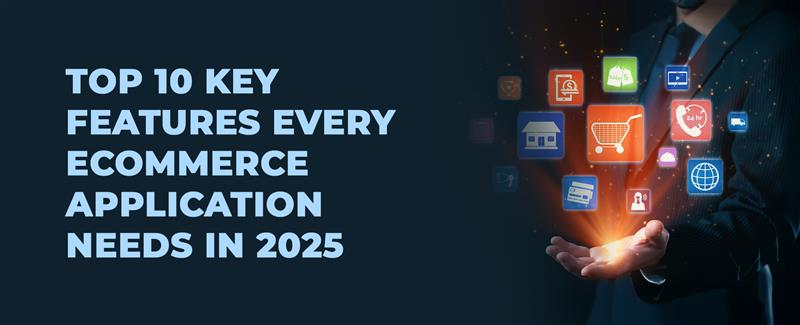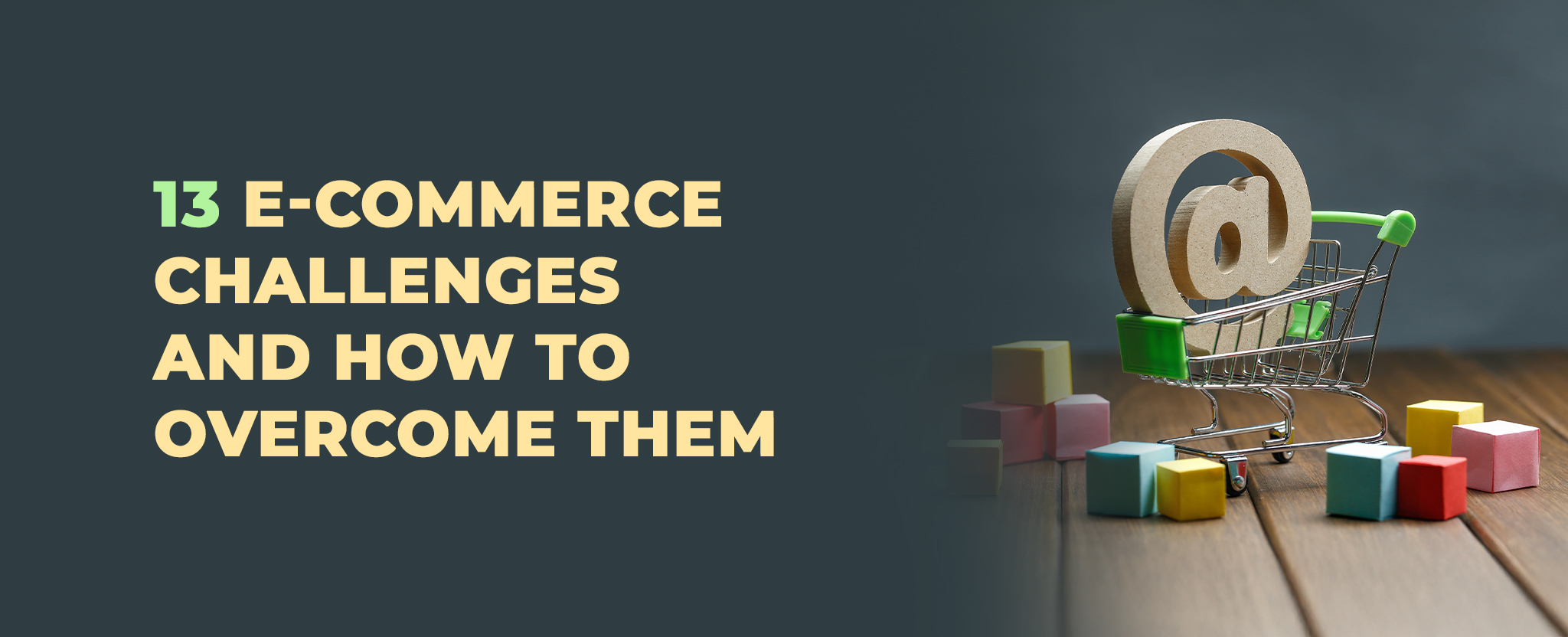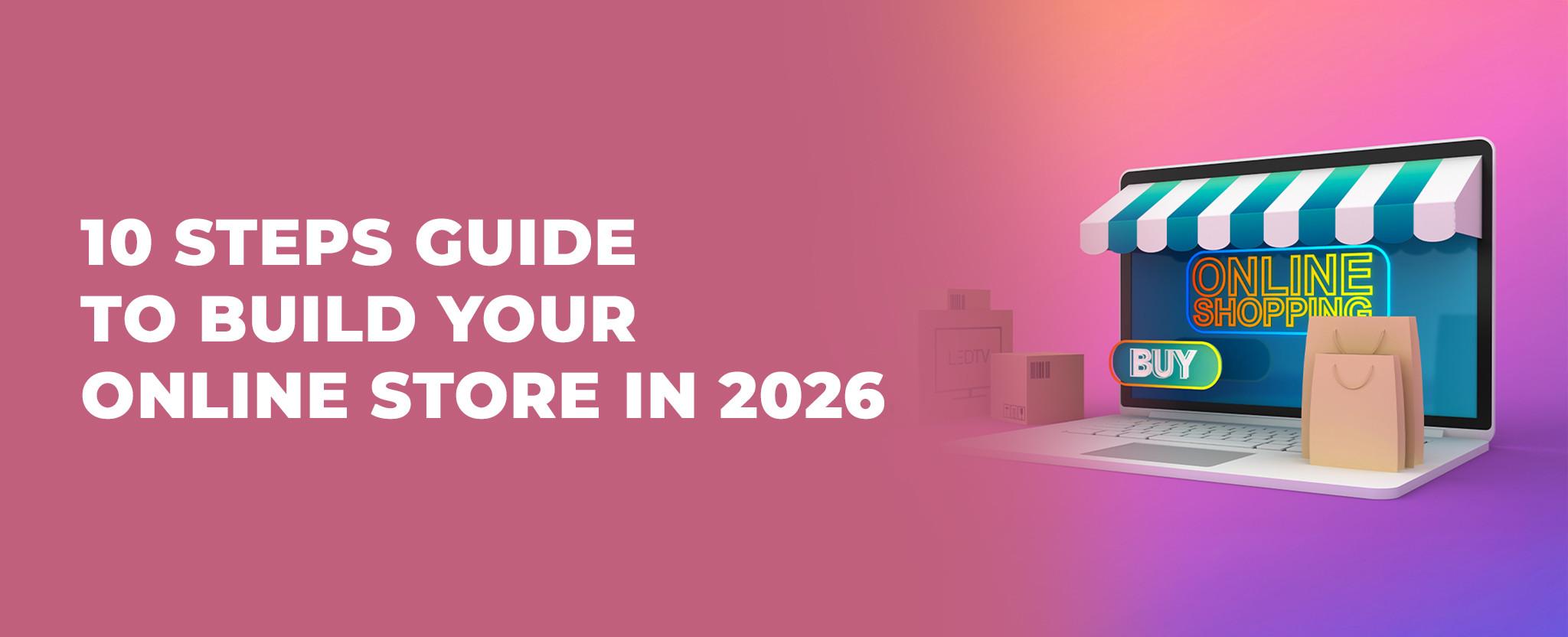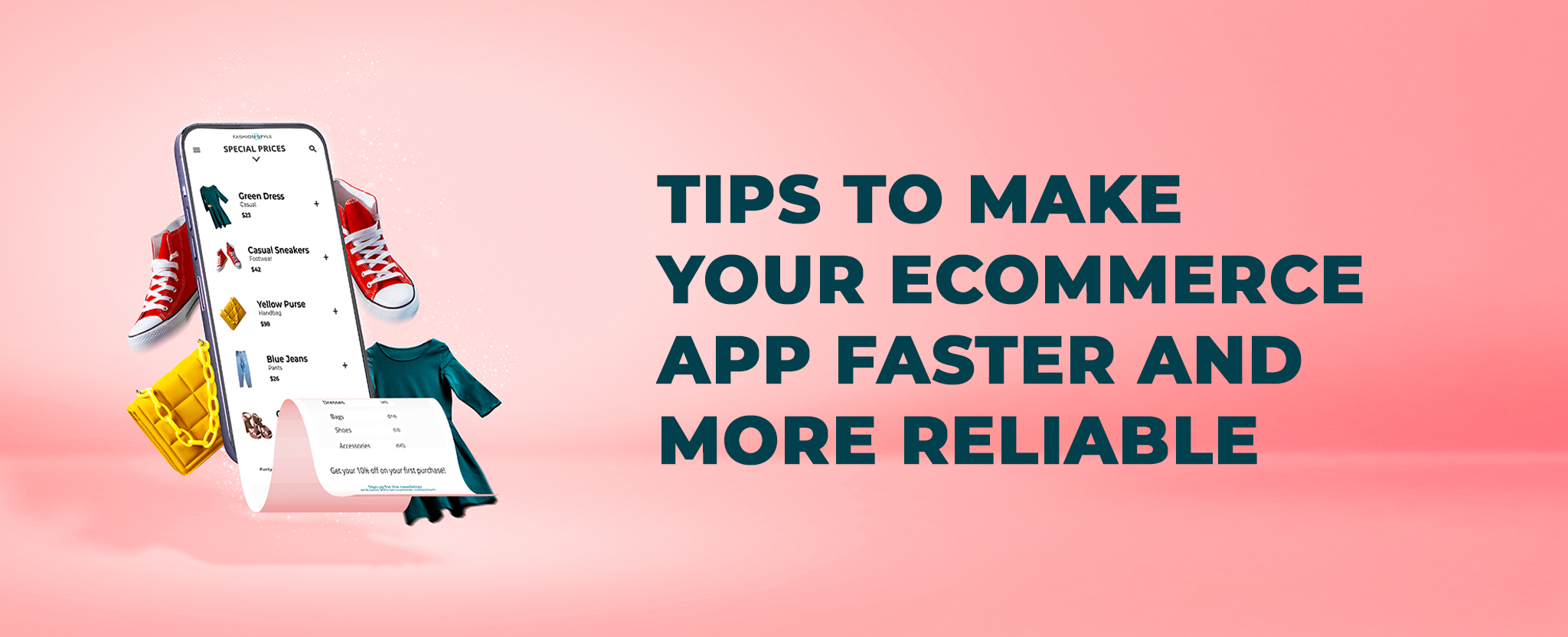Top 10 Key Features Every Ecommerce Application Needs in 2025
4 Mar 25 


Have you ever found yourself scrolling endlessly through an online store, searching for that perfect item in your favorite color? Well, imagine if that process could be made quicker and easier. With AI-powered personalization, your shopping experience can be transformed.
As we step into 2024, the world of e-commerce is evolving, and so are the expectations of online shoppers. One of the key trends we can expect to dominate the industry is the use of AI to create smooth shopping journeys.
In this blog, we will explore the top app features that e-commerce businesses should consider adopting in the coming year. From AI-powered personalization to seamless payment options, we will delve into the trends that will shape how we shop online.
What are E-commerce Apps?
eCommerce, or electronic commerce, is a method of purchasing and selling goods online. It’s similar to going to the store, but instead of walking along the aisles, you browse a website or application. These eCommerce apps are intended to display you things, make it easy to purchase them, and then deliver those products to you. They also serve as a marketing tool, suggesting things you might be interested in and giving you sales notifications. You may have used eCommerce apps such as Amazon or eBay, which allow you to buy items from the convenience of your home. These apps are designed to make shopping easy and secure, allowing you to shop with only a few clicks on your smartphone!
Benefits of E-Commerce Apps
E-commerce apps have changed the way businesses operate and how consumers shop. Here are some key benefits of e-commerce apps:
1. Convenience
- 24/7 Accessibility: E-commerce apps allow customers to shop anytime and anywhere, providing an unparalleled level of convenience. This means your store is always open, no matter the time or location of the customer.
- Ease of Use: Customers can easily browse, compare, and purchase products from their mobile devices, making the shopping process quick and straightforward.
2. Personalization
- Tailored Experiences: E-commerce apps can offer personalized recommendations based on user behavior, preferences, and purchase history, creating a more engaging shopping experience.
- Customer Engagement: Personalized notifications and offers can keep customers engaged and encourage repeat purchases.
3. Data Analytics
- Insightful Data: E-commerce apps provide valuable data on user behavior, trends, and preferences. This information can be used to optimize marketing strategies, inventory management, and overall business operations.
- Informed Decisions: Analyzing this data helps businesses to make informed decisions that can enhance customer satisfaction and increase sales.
4. Cost-Efficiency
- Lower Overheads: Developing and maintaining an e-commerce app can be more cost-effective than running a physical store, as it reduces the need for physical space and staff.
- Scalability: E-commerce apps allow businesses to scale their operations without significant additional costs, enabling them to reach a larger audience globally.
5. Enhanced Customer Experience
- User-Friendly Interface: E-commerce apps are designed to provide a seamless and intuitive shopping experience, with features like easy navigation, fast loading times, and secure payment options.
- AR Integration: Advanced technologies like Augmented Reality (AR) can be integrated into e-commerce apps, allowing customers to visualize products in their own environment before making a purchase.
6. Increased Sales and Revenue
- Broader Reach: E-commerce apps enable businesses to reach a wider audience beyond geographical limitations, potentially increasing sales and revenue.
- Impulse Buying: Features like one-click purchasing and push notifications can encourage impulse buying, boosting sales.
7. Competitive Advantage
- Staying Ahead: By adopting the latest e-commerce trends and technologies, businesses can stay ahead of the competition and meet evolving consumer demands.
- Brand Loyalty: Offering a seamless and personalized shopping experience can help build brand loyalty and foster long-term customer relationships.
8. Mobile Commerce Growth
- Rising Trend: With mobile commerce expected to account for a significant portion of e-commerce sales, having a dedicated mobile app is crucial for capturing this growing market segment.
- Smartphone Usage: As more consumers use their smartphones for online shopping, businesses with e-commerce apps are well-positioned to capitalize on this trend.
You may also read:The Best Guide to B2B E-commerce: Definition, Types, Benefits & Best Practices
Key Ecommerce App Features
1. AI-powered Personalization
AI-powered personalization is transforming the eCommerce landscape by offering tailored shopping experiences that significantly enhance user engagement and sales. This technology leverages machine learning and data analytics to understand and predict customer preferences, making every interaction unique and relevant.
Product Recommendations
AI-driven product recommendations analyze customer behavior, such as browsing history and purchase patterns, to suggest items that are most likely to appeal to them. This not only improves the customer experience by making shopping more relevant and less time-consuming but also increases the likelihood of purchase. For instance, platforms like Amazon and Netflix use these personalized recommendations to boost user engagement and satisfaction, leading to higher conversion rates.
Dynamic Pricing
Dynamic pricing adjusts the prices of products in real-time based on various factors like market demand, competitor pricing, and user behavior. This strategy allows businesses to stay competitive and maximize profits by offering the right price at the right time. For example, Amazon’s pricing algorithm changes prices frequently, which has been shown to significantly increase sales and customer retention.
Personalized Email Marketing
Email marketing can be highly effective when personalized. AI helps segment customers based on their behavior and preferences, allowing for targeted messages that are more likely to resonate with the recipient. Personalized emails go beyond using the customer’s name; they include content relevant to the individual’s interests and previous interactions with the brand.
To ensure your campaigns reach the right audience, a bulk email verifier can be used to clean and validate email lists, reducing bounce rates and improving overall deliverability. This approach not only enhances the open and click-through rates but also strengthens customer loyalty by providing a more personalized shopping experience.
For businesses looking to boost their branding and personalization efforts, adding an email signature can further enhance each message, reinforcing trust and connection with customers.
Incorporating AI-powered personalization into your eCommerce strategy offers a distinct competitive advantage by creating more meaningful connections with your customers and ultimately driving increased sales and customer loyalty.
2. Voice Commerce Integration
Voice Commerce Integration is revolutionizing the way you shop online by seamlessly incorporating voice-based technologies into your ecommerce platform. This integration enhances the user experience by making it more interactive and accessible, especially for tasks like searching and shopping through voice commands.
Voice Search Optimization
Optimizing your ecommerce site for voice search is crucial as it improves visibility and accessibility through speech recognition technology. By focusing on conversational keywords and implementing structured data, your products become more discoverable via voice queries. This ensures that when customers use voice search to find products or services, your offerings stand out, potentially increasing traffic and sales.
Voice-activated Shopping
Voice-activated shopping transforms the shopping experience by allowing customers to use their voice to execute purchases. Integrating virtual assistants like Alexa, Siri, and Google Assistant into your ecommerce system enables users to perform a variety of actions such as adding items to their cart and checking out, all hands-free. This not only streamlines the buying process but also enhances customer satisfaction by providing a convenient and innovative shopping method.
3. Virtual Assistants
Virtual assistants are integral to enhancing voice commerce by performing tasks ranging from managing schedules to assisting with complex purchase decisions. These assistants learn from user interactions to offer personalized shopping experiences and support. By incorporating advanced AI, these systems understand and predict user preferences, making each interaction smoother and more tailored to individual needs.
Incorporating voice commerce into your ecommerce strategy offers a competitive edge by catering to evolving consumer behaviors and preferences, making shopping not just convenient but also a futuristic experience.
4. One-click Ordering

One-click ordering revolutionizes the shopping experience by simplifying the checkout process, making it faster and more user-friendly. This feature is crucial for enhancing customer satisfaction and boosting conversion rates.
Saved Payment Information
One-click ordering relies heavily on securely saved payment details. By storing billing and shipping information, ecommerce platforms enable you to breeze through the checkout process without the need to re-enter details. This not only saves time but also reduces the friction associated with multiple-step checkouts, encouraging repeat purchases and customer loyalty.
Express Checkout

The express checkout feature streamlines the buying process by allowing you to complete purchases with minimal steps. This is particularly advantageous for returning customers who can benefit from the convenience of not having to enter their details each time. It’s designed to facilitate quicker transactions, thereby reducing cart abandonment and enhancing the overall user experience.
Reorder Functionality
For regular customers, the reorder functionality is a game-changer. It allows you to easily repurchase products that are frequently needed, such as groceries or office supplies. This feature not only saves time by eliminating the need to search for the same products again but also offers personalized recommendations based on past purchases, which can lead to increased customer satisfaction and loyalty.
Integrating one-click ordering into your eCommerce application can significantly enhance the user experience by making shopping convenient, quick, and hassle-free. This feature is especially effective in capturing the impulse buy market, as it minimizes the time and effort required to make a purchase, thereby encouraging more spontaneous decisions.
Advanced Product Filtering
Advanced product filtering is essential for enhancing the shopping experience on your eCommerce platform. By allowing customers to quickly narrow down their options, you improve user engagement and increase the likelihood of a sale. Here’s how you can implement effective product filtering:
Attribute-based Filters
Attribute-based filters are a cornerstone of user-friendly eCommerce sites. These filters allow customers to sort products based on specific characteristics such as size, color, and material. For example, if a customer is looking for dinnerware, they can select filters like product type (e.g., plates, bowls), material (e.g., stoneware, porcelain), and color (e.g., white, blue). This targeted approach helps customers find exactly what they need without sifting through irrelevant options, enhancing the shopping experience and reducing cart abandonment.
Price Range Sliders
Price range sliders provide a dynamic way for customers to filter products within a specific budget. Instead of fixed price categories, sliders allow for more flexible adjustments, accommodating various price points. However, it’s crucial to implement sliders that are not overly sensitive, as this can frustrate users. Opting for non-linear slider scales, like logarithmic or biased scales, can offer better control, making it easier for customers to select a price range without constant adjustments.
Brand Filtering
For eCommerce sites that feature a wide range of brands, brand filters are invaluable. By allowing customers to filter by their preferred brands, you streamline their shopping process. It’s beneficial to position popular brands at the top of the filter list to enhance visibility and accessibility. This approach not only speeds up the shopping experience but also caters to brand-loyal customers, potentially increasing their satisfaction and loyalty to your platform.
Implementing these advanced filtering options will significantly improve the functionality and user experience of your eCommerce application. By making it easier for customers to find and select products, you’re likely to see an uptick in user engagement and sales.
5. Social Commerce Features
Social commerce integrates your ecommerce activities directly within social platforms, enhancing the shopping experience without disrupting user engagement. This integration allows customers to discover, interact, and purchase products seamlessly.
Shoppable Posts
Platforms like Instagram and TikTok have revolutionized shopping with shoppable posts. By tagging products in images or videos, users can click on these tags to see product details and complete purchases without leaving the social media app. This direct approach not only simplifies the buying process but also keeps the user engaged with your content. Platforms now allow users not only to shop but also to produce images with AI, creating visually captivating and personalized shopping accessories. With AI-driven tools accommodating user preferences, propel product engagement with digital creativity at its core.
User-generated Content
User-generated content (UGC) is a powerful tool that leverages authenticity and trust. Encouraging your customers to share their experiences and reviews creates a community around your brand and influences new customers. Platforms like Instagram and TikTok allow users to share their content, which brands can repurpose to enhance credibility and reach. For example, integrating customer reviews and images on product pages can significantly boost conversion rates.
Social Media Login
Incorporating social media login options simplifies the registration and sign-in process, enhancing user convenience and increasing the likelihood of transaction completion. This feature allows users to use their existing social network accounts to log in to your ecommerce site, reducing barriers and accelerating the checkout process. By offering options like Facebook, Google, or Twitter login, you cater to a broader audience, ensuring a smoother and quicker user experience.
By focusing on these social commerce features, you provide a streamlined, engaging, and efficient shopping experience that can lead to increased sales and customer loyalty.
6. Mobile Wallet Integration
Mobile wallet integration is becoming a staple in eCommerce applications, offering you a seamless and secure way to manage transactions. With the increasing adoption of digital payments, integrating mobile wallets like Apple Pay, Google Pay, and Samsung Pay into your eCommerce platform can enhance the checkout experience and potentially increase conversion rates.
Apple Pay
Apple Pay provides a secure and private way to conduct transactions using iOS devices. By utilizing NFC technology, Apple Pay allows for contactless payments in-store and simplifies online purchases. Each transaction is authenticated via Face ID or Touch ID, ensuring security. The integration of Apple Pay on your platform can be done through configuring payment gateways that support it, like Stripe or Braintree, enhancing the user experience by making checkout processes swift and secure.
Google Pay
Google Pay, known for its convenience across Android devices, uses NFC for contactless in-store payments and facilitates online transactions by selecting it as a payment option. The service does not store your actual credit card number but uses a virtual account number for transactions, providing an added layer of security. Integrating Google Pay into your eCommerce site can attract a wider audience by offering a familiar and trusted payment method.
Samsung Pay
Samsung Pay stands out with its compatibility with both NFC and MST (Magnetic Secure Transmission) technologies, allowing it to work with nearly any payment terminal. The service enhances security by using tokenization where a unique token represents your payment information. Integrating Samsung Pay can provide your customers with flexibility in payment methods and enhance the security of transactions.
By incorporating these mobile wallets into your eCommerce application, you offer your customers a variety of secure and convenient payment options, making their shopping experience smoother and potentially boosting your sales.
7. Real-time Inventory Updates
Real-time inventory updates are crucial for maintaining customer satisfaction and optimizing sales opportunities in your eCommerce store. By effectively managing stock availability, sending timely back-in-stock notifications, and offering pre-order options, you can significantly enhance the shopping experience and retain customer loyalty.
Stock Availability
Ensuring that your eCommerce platform reflects accurate stock levels in real-time is essential. This transparency helps prevent customer disappointment and reduces the likelihood of cart abandonment due to out-of-stock items. Implementing robust inventory management systems that sync across all sales channels ensures that your customers see real-time availability, which helps in making informed purchasing decisions.
Back-in-stock Notifications
Back-in-stock notifications are a powerful tool to recapture the interest of customers who encounter out-of-stock items. By allowing customers to subscribe to alerts, you can keep them engaged and encourage return visits to your store. Customize these notifications with your brand’s voice and include urgency phrases like “Limited stocks” or “Only for 24 hours” to prompt quick action from the customers. This strategy not only enhances customer experience but also boosts your sales by recovering potentially lost opportunities.
8. Pre-order Options
Offering pre-order options for items not yet available is an excellent strategy for managing customer expectations and securing sales ahead of stock availability. This approach allows you to gauge demand and adjust production or ordering accordingly. Pre-orders can be particularly effective when combined with strategic marketing efforts, creating anticipation and exclusivity around your products. Ensure to communicate clearly about expected shipping dates and keep your customers informed throughout the process to maintain trust and satisfaction.
By integrating these strategies into your eCommerce application, you can provide a seamless and responsive shopping experience that adapulates to customer needs and market demands, positioning your business for continued growth and success in the competitive online marketplace.
9. Multi-language and Currency Support

In today’s global market, the ability to cater to diverse linguistic and financial preferences is crucial for any ecommerce platform. Multi-language and currency support not only broadens your market reach but also enhances user experience by providing a personalized shopping environment.
Automatic Language Detection
Implementing automatic language detection simplifies user interaction by automatically adapting the ecommerce site to the language of the user’s browser or location settings. This feature ensures that customers are immediately comfortable with navigating your site, which can lead to increased engagement and sales.
Currency Converter
A robust currency converter is essential for international transactions. It allows customers to see product prices in their local currency, reducing confusion and enhancing transparency. This feature should include real-time exchange rate updates to ensure that pricing remains accurate and fair, encouraging trust and loyalty among global customers.
Localized Content
Localized content goes beyond mere translation; it involves adapting your content to reflect local cultural nuances and shopping habits. This includes tweaking marketing messages, adjusting visual elements, and ensuring that all communications resonate with the local audience. Localizing content can significantly increase relevance and appeal, making your platform more inviting and relatable to diverse user groups.
By integrating these features into your ecommerce application, you provide a seamless and inclusive shopping experience that meets the expectations of a global audience. This not only sets your platform apart but also builds a foundation for long-term customer relationships across various regions.
Enhanced Customer Support
Enhanced customer support in eCommerce applications is evolving rapidly, focusing on providing faster, more personalized, and proactive solutions to enhance the shopping experience. By implementing innovative support mechanisms, businesses can significantly increase customer satisfaction and retention.
24/7 Support
The implementation of 24/7 support systems addresses one of the most significant pain points in customer service: availability. By ensuring that help is always at hand, whether through AI-driven chatbots or round-the-clock customer service teams, you ensure that your customers feel valued and supported at all times. This constant availability not only improves customer satisfaction but also helps in retaining customers who might otherwise seek solutions from competitors.
Video Chat
Video chat is becoming an integral part of digital customer service strategies, providing a personal touch that other digital mediums cannot match. By incorporating video chat, businesses can mimic in-store experiences online, offering real-time interactions that build trust and rapport. Customers appreciate the face-to-face communication, which often leads to quicker resolutions and higher satisfaction rates. For businesses, video chat can reduce the reliance on physical locations, lower operational costs, and enhance overall service efficiency.
Self-service Portals
Self-service portals empower customers by giving them control over their interactions with your eCommerce platform. These portals allow users to manage their accounts, track orders, process returns, and access help resources independently, without needing to contact customer support directly. By facilitating a self-help culture, you not only improve customer satisfaction by providing instant access to information and services but also reduce the workload on your customer service team, allowing them to focus on more complex queries. Additionally, these portals collect valuable customer data, enabling you to refine your strategies and offerings.
Incorporating these advanced support features into your eCommerce application not only meets the rising expectations of modern consumers but also positions your business as a customer-centric brand in a competitive digital marketplace.
10. Progressive Web App (PWA) Functionality
Progressive Web Apps (PWAs) offer a blend of traditional website behaviors and native app features, making them an essential component in modern eCommerce applications. By leveraging service workers, the Cache API, and IndexedDB, PWAs provide an unparalleled user experience, even in offline settings. Here’s how these features translate into tangible benefits for your eCommerce strategy.
Offline Mode
PWAs excel in providing offline functionality, allowing you to browse product catalogs, modify shopping carts, and manage wishlists without an internet connection. This is achieved through:
- Service Workers: These act as a network proxy, enabling PWAs to cache and serve content offline.
- Cache API: It stores resources like HTML, CSS, and images, which speeds up load times and ensures availability offline.
- IndexedDB: This allows for the storage of large amounts of structured data offline, including user profiles and product details.
These technologies ensure that even when connectivity is limited, your shopping experience remains smooth and uninterrupted.
Push Notifications
Push notifications are a powerful tool for maintaining user engagement with your eCommerce platform. They allow you to:
- Engage Users Effectively: By sending timely updates about new products, promotions, or order statuses directly to users’ devices.
- Enhance Promotional Strategies: Notifications are seen three times more than email, increasing the effectiveness of your marketing efforts.
- Operate Without Internet: Notifications can be received even when the device is offline, thanks to service workers.
This direct communication channel keeps users informed and connected to your brand, boosting retention and conversion rates.
App-like Experience
PWAs provide an app-like experience on any device, enhancing user interaction and satisfaction through:
- Home Screen Installation: Users can easily add your PWA to their home screen without the need for an app store.
- Full Functionality Across Devices: Whether on a mobile, tablet, or desktop, PWAs maintain consistent functionality and user experience.
- Access to Device Features: PWAs can interact with cameras, sensors, and other hardware to enhance the user experience.
By integrating PWA functionality into your eCommerce application, you not only cater to the needs of a diverse user base but also ensure that your platform is adaptable to varying network conditions, promoting greater accessibility and user engagement.
Final Thoughts
The key to a top e-commerce app is user-centric features that make shopping easy, enjoyable, and secure. From seamless navigation and personalized recommendations to hassle-free checkout and reliable customer support, a great e-commerce app focuses on enhancing the overall shopping experience for its users.
Are you in search of a top-notch mobile app development company for your advanced e-commerce app? Look no further! Mindster is your ideal choice for modifying your shopping experience digitally with our changing digital transformation using our e-commerce app.
- Agentic AI1
- Android Development3
- Artificial Intelligence35
- Classified App3
- Custom App Development5
- Digital Transformation12
- Doctor Appointment Booking App14
- Dropshipping1
- Ecommerce Apps40
- Education Apps2
- Fintech-Apps37
- Fitness App4
- Flutter4
- Flutter Apps20
- Food Delivery App5
- Grocery App Development1
- Grocery Apps3
- Health Care10
- IoT2
- Loyalty Programs9
- Matrimony Apps1
- Microsoft1
- Mobile App Maintenance2
- Mobile Apps130
- Product Engineering6
- Progressive Web Apps1
- React Native Apps2
- Saas Application2
- Shopify9
- Software Development3
- Taxi Booking Apps7
- Truck Booking App5
- UI UX Design8
- Uncategorized6
- Web App Development1



















Comments